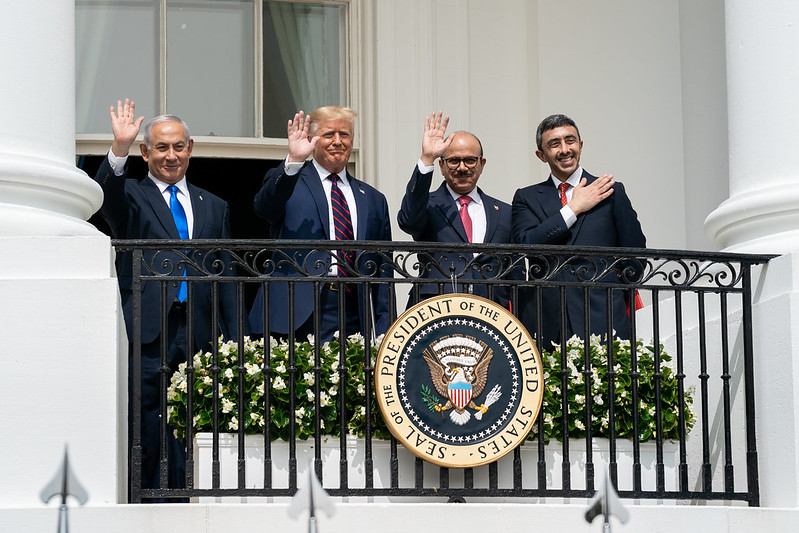
President Donald J. Trump, joined by the Minister of Foreign Affairs of Bahrain Dr. Abdullatif bin Rashid Al-Zayani, Israeli Prime Minister Benjamin Netanyahu and the Minister of Foreign Affairs for the United Arab Emirates Abdullah bin Zayed Al Nahyan, acknowledge applause and wave to the crowd after delivering remarks at the Abraham Accords signing Tuesday, Sept. 15, 2020, on the South Lawn of the White House. (Official White House Photo by Andrea Hanks)
After leaving office with the world in relative peace in 2020, Donald Trump inherits a world left in turmoil by the Biden/Harris administration, with major wars happening in Ukraine/Russia and the Middle East. At the Cato Institute, Jon Hoffman discusses what Trump faces in the Middle East as Israel battles against Iran and its proxies in the region. A return to the very successful Abraham Accords peace process Trump undertook in his first term would be welcome. Hoffman writes:
President-elect Trump faces a tall order in the Middle East.
More than 13 months after Hamas’ terror attack against Israel on October 7, 2023, and Israel’s wars in Gaza and Lebanon, there is no end in sight to the violence. The Middle East remains on the brink of full-scale, region-wide war, with the potential for direct U.S. involvement. The decision by Washington to place itself at the center of these conflicts is a symptom of a broader self-defeating U.S. Middle East policy.
To fix this, Trump should center U.S. Middle East policy on two chief objectives: disentanglement and deprioritization.
The most immediate issue in the Middle East is America’s deep involvement in Israel’s wars in Gaza and Lebanon, and in the continued escalation between Israel and Iran.
From the very first days of the war in Gaza — and now, Lebanon — it was clear that Israel was in the driver’s seat, with the United States in tow. Washington’s regional strategy has been reactive in nature, often responding to developments with tepid warnings and empty threats while continuing to provide the arms, military aid, and diplomatic cover that allow Israel’s wars to continue.
In both Gaza and Lebanon, Israel’s wars are devoid of discrete and achievable political objectives.
In Gaza, Israel’s stated objectives are the total elimination of Hamas, and the return of the hostages seized during Hamas’ attack on October 7. Yet, neither has been achieved. The Israeli defense establishment views these two objectives as mutually incompatible, and American officials believe Israel has accomplished all it can militarily in Gaza.
While Hamas is certainly battered and degraded, the group is far from eliminated and has resorted to guerilla tactics against the Israeli military, often popping up in locations Israel previously claimed to have cleared, and it maintains its ability to recruit volunteers. Israel is demanding a lasting military presence in the enclave — something Hamas has rejected as a precondition for a ceasefire and hostage deal.
Israel can degrade Hamas’ capabilities and kill its leaders, but without a route toward a new political equilibrium, violence will persist.
In Lebanon, Israel’s military campaign is growing, with Amos Hochstein, special adviser to President Biden on the Israel-Hezbollah conflict, recently claiming the situation has “escalated out of control.”
Israel’s stated objectives in Lebanon are destroying Hezbollah’s military infrastructure in the country’s south and returning the roughly 60,000 Israeli citizens displaced from Israel’s north. However, as in Gaza, Israel appears to be planning for a prolonged military presence in Lebanon. Hezbollah has ruled out negotiations so long as fighting with Israel continues, and is putting up a stiff resistance against Israeli forces despite major setbacks suffered by the group.
Hanging over both of these wars are the back-and-forth military exchanges between Israel and Iran. Washington has placed itself at the center of this escalatory cycle.
Read more here.
If you’re willing to fight for Main Street America, click here to sign up for my free weekly email.




